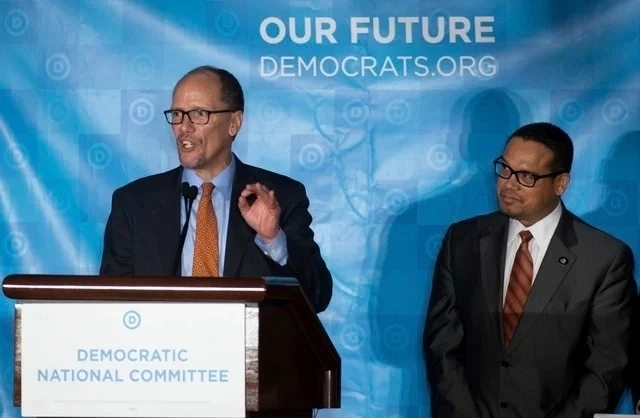The Democrats and The Resistance
Published at HuffPost.
Donald Trump is president and Republicans control just about everything.
Meanwhile Democratic Party leaders who paved the way for this Republican resurgence seem to view themselves as natural leaders in the fight against Trump, known as the “Resistance.”
But are they up to the challenge?
Recall how badly they screwed up in 2016.
In capturing the Republican nomination, Trump became the most disliked presidential nominee in recent times.
This presented Democrats with an opportunity to not only keep the White House, but also make big gains in the House and Senate.
Instead Democrats rigged their own primaries, allowing Trump to face the second most-disliked nominee in recent times, Hillary Clinton.
Now the folks who helped pull this off want to lead the Resistance.
2018
Democrats face an uphill fight in the 2018 elections.
In the Senate, Democrats must defend 23 seats, compared to just eight for Republicans. Meanwhile gerrymandered House districts continue to favor Republicans (who control most state legislatures, which draw the districts).
On top of this, the right-wing Koch network is expected to again pour in big money to back Republicans, including as much as $400 million ahead of the 2018 elections. In 2016, the Koch network targeted eight senate races, winning seven.
Still, it’s possible to defeat the Kochs and Republicans, as President Obama’s two terms show.
With the 2018 election on the horizon, the good news for Democrats is there’s a groundswell of energy and anger, and a growing determination to take on Trump.
The bad news is the party’s leaders are reluctant to unleash this tidal wave, possibly fearing they might be swept up in it themselves.
Sanders Supporters Out in the Cold, Again
In the 2016 Democratic primary, party leaders helped ensure Clinton’s victory over Bernie Sanders, whose candidacy was fueled by millions of passionate supporters.
Despite this mistreatment, Sanders’ supporters didn’t bolt the party. Instead they coalesced again, this time around Congressman Keith Ellison’s bid for chair of the Democratic National Committee.
But once again, rather than welcoming in this much-needed energy, party insiders worked to keep Sanders supporters out in the cold.
The campaign to stop Ellison, the first-ever Muslim elected to Congress, included accusations of anti-Semitism.
“What is being done to Ellison,” The Intercept’s Glenn Greenwald wrote, “is Islamophobia in its purest and most classic form.”
Ultimately, Ellison was narrowly defeated by Tom Perez. The former Labor Secretary under President Obama jumped into the DNC race a month after Ellison, at the urging of top Obama officials.
Perez challenged Ellison despite the similarity of their progressive politics, a point Perez and his supporters stressed.
“This is… why the case for Tom Perez makes no sense,” wrote The New Republic’s Clio Chang. “If Perez is like Ellison—in both his politics and ideology—why bother fielding him in the first place?”
With Ellison’s loss, party leaders once again pushed Sanders supporters to the outskirts.
“At this point, one has to conclude that the national Democratic Party has a death wish,” Nathan Robinson wrote in Current Affairs. “The progressives needed to receive some kind of gesture. And they have received one: an enormous middle finger.”
But maybe the Democratic Party can overcome this with a strong message.
If only they had one.
What Do They Stand For?
What does the Democratic Party stand for? And what’s its strategy to retake the government?
When activist and New York Daily News writer Shaun King puts these questions to audiences, “The response that I get is always the same – mass laughter or audible frustration.”
This is not a good sign for Democrats.
Nor is a recent poll from Suffolk University, which found Democrats aren’t that popular.
“At a time when Donald Trump is the least liked President ever measured at this point in his first term,” King wrote, citing the poll, “the Democratic Party has found a way to be even less liked than him.”
To be clear, not all the news of late has been bad for Democrats. In a string of special elections since Trump’s win, the party has seen increased turnout. But Democrats still have a lot of ground to make up (they lost nearly 1,000 legislative seats during Obama’s presidency).
Russian Roulette
As the Democratic Party struggles to find its footing, one of its stars is soaring.
A recent Fox News poll shows Bernie Sanders is far and away the nation’s most popular politician.
“Yet bizarrely, the Democratic party – out of power across the country and increasingly irrelevant – still refuses to embrace him and his message,” writes The Guardian columnist Trevor Timm.
What distinguishes Sanders is his unrelenting focus on issues impacting workers and the poor. Meanwhile the rest of the party is more concerned with Trump being in cahoots with Putin and Russia, despite the evidence being less than rock solid.
While hyping Trump’s alleged ties to Russia doesn’t appear to be helping the party, it is having an effect on the base, which is increasingly frightened.
Trying to bring Trump down by tying him to Russia carries with it more than just political risks, writes Robert Parry of Consortiumnews.
[If] Trump finds himself having to demonstrate how tough he can be on Russia — to save his political skin — he could easily make a miscalculation that could push the two countries into a war that could truly be the war to end all wars.
Yet desperate Democrats push on, ignoring polls and common sense.
“Meanwhile, while Russia continues to dominate the front pages,” Putin critic Masha Gessen writes in the New York Review of Books, “Trump will continue waging war on immigrants, cutting funding for everything that’s not the military, assembling his cabinet of deplorables.”
And as Trump carries out his extreme agenda, leaders of the Democratic Party – and ostensibly the Resistance – keep the floodgates closed, no matter the cost.
Photo Credit: AP


